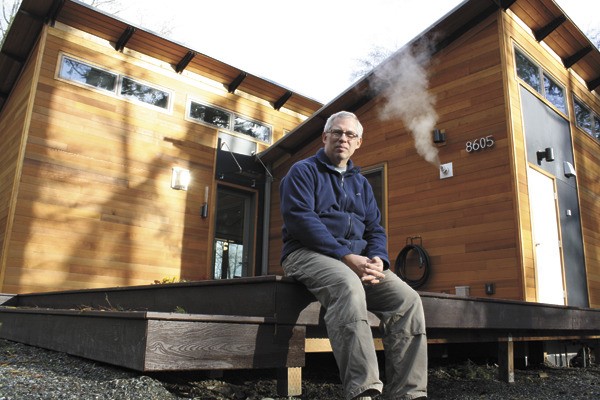Islander Richard Mintz’s new home is from East Springfield, Mass. Four huge semi-trucks drove 3,000 miles over 10 days to cross Puget Sound and deliver the home to Vashon. And Mintz says he couldn’t be happier with the delivery.
The 2,000-square-foot home he now shares with his wife Diane McGaha in Dilworth is a high-end, super-green manufactured home. Everything in the so-called Glidehouse, from the large clerestory windows to the ventilated crawlspace and airtight insulation, was designed to conserve energy and cut carbon emissions. The structure itself, from the recycled steel frame to the bamboo floors and nontoxic paint, is built from healthy and sustainable building materials.
“Some people call it the bleeding edge,” Mintz said, sitting in his new home last month. “I call it the leading edge of what everyone will be worried about in 10 years.”
The couple fell in love with the Glidehouse almost a decade ago when the design premiered on the pages of Sunset magazine. They lived in a small home on outer Quartermaster Harbor at the time, but also owned two acres of property perched above the water on Dilworth Point that they planned to one day move to. The stylish and cutting-edge green house with an entire wall of windows seemed like a dream home for the spot, Mintz said.
The dream didn’t become a reality, however, until last year. Mintz, a former U.S. Air Force pilot and retired Boeing engineer, and McGaha, a lawyer, had given up on the Glidehouse after the housing market crashed and the home’s original designer stopped selling it. They were looking into other options in green home building when they learned the Glidehouse design had been purchased by Blu Homes, a Massachusetts-based builder of eco-friendly prefabricated homes.
“People already think I’m a loon. That would probably confirm it if I bought a house from Massachusetts,” Mintz, recalling his thinking, said with a laugh.
When the couple, who was considering purchasing a similar manufactured home from a Seattle-based designer, found it would cost about the same to ship a Glidehouse from the East Coast, there was no question, Mintz said. They still loved the Glidehouse.
“It has worked out, knock on wood,” Mintz said.
It took Blu Homes workers two days to unfold the Glidehouse on Vashon last October, and after about two months of preparations such as wiring and painting, it was ready to live in.
The 1,600-square-foot home and adjoining 300-square-foot “pod” the couple chose as an add-on guest house, are bright and open, with tall, vaulted ceilings and a clean and modern interior design.
The 48-foot wall facing Puget Sound is entirely windows with sliding glass doors built in, providing panoramic views of the water and Mount Rainier.
Opposite the windows, a wall of sleek cabinetry leads into a kitchen full of stainless steel Energy Star appliances. Warm bamboo flooring is complemented by sleek black countertops in the kitchen and living room. Mintz said the counters are made from an extremely durable recycled material similar to what it used in bulletproof vests.
On the other side of the home are two equally airy bedrooms, an office and two bathrooms built to conserve water and provide wheelchair access, if needed.
Mintz said he likes the Glidehouse’s clean, modern look. Perhaps more importantly, though, he’s glad his new home is good for the environment.
According to Blu Homes, Glidehouses are about 50 percent more energy efficient than the average existing home. One of the biggest cost savings comes from heating the home. Propane powers radiant in-floor heating, and thick insulation and airtight construction keeps heat from escaping.
Considering the cost of the Glidehouse — about $380,000 for the main house and an additional $100,000 for the pod — Mintz said there aren’t huge savings in the end. But, he said, building green is simply the right thing to do.
“It’s a social obligation. … It’s almost a moral and ethical need to be conscious of our use of energy and resources,” he said.
Mintz also thinks the investment might pay off down the road. He compared buying a Glidehouse to purchasing an electric vehicle, saying the cars are pricier now but may save drivers significantly if gas prices continue to rise.
“I think it’s good preparation for the future,” he said. “I think energy costs are going to go up. … I think ultimately it will be a smart move.”
It’s a move more and more Americans are taking. Manufacturers of uber-green prefabricated homes are popping up all over the country, with at least three now headquartered in Seattle.
Mintz’s Glidehouse isn’t the first on the Island. Ami McElroy has lived in one at Gold Beach for a half-a-dozen years. She said she’s been happy with the house — she loves the modern style and its abundance of natural light.
McElroy has thought of leaving the Island to be closer to work and her daughter’s new school, she said, but she couldn’t stand to leave the Glidehouse.
“I can’t move. I just love the house,” she said.
As for Mintz, he says he has barely settled in his Glidehouse, but so far he loves watching the world go by on the water and he’s impressed with how efficiently the home is heated — the temperature barely drops while the heat is turned down at night.
“I’m looking forward to being able to say this house uses less energy,” he said.
Mintz has plans to plant a garden outside the house and harvest rainwater for it from the roof. And he hopes to eventually add solar panels to the solar-ready home.
“That’s my goal — to have a power meter that’s at zero or running backwards,” he said.
To see the entire Home & Garen special section, pick up a copy of this week’s Beachcomber.



